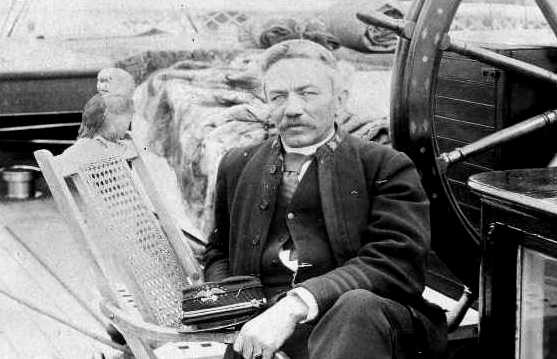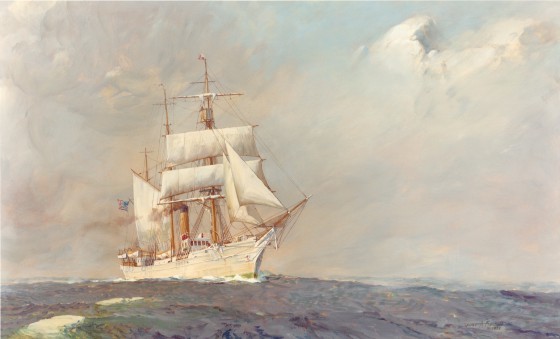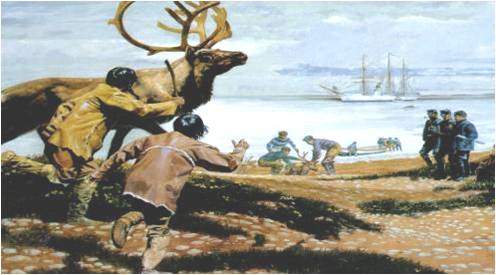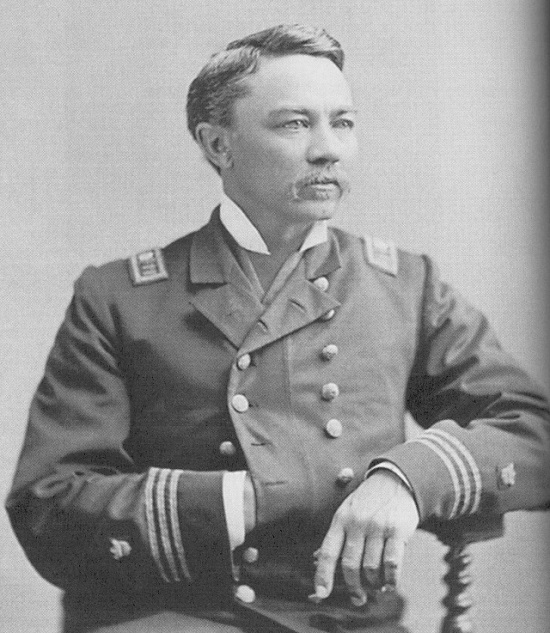Captain Mike Healy: Tamer of America's Western Sea Frontier
By William Thiesen, Atlantic Area Historian for the U.S. Coast Guard

The colorful Captain “Hell Roaring” Mike Healy, famed skipper of the Bear. U.S. Coast Guard photo.
“When I am in charge of a vessel, I always command; nobody commands but me. I take all the responsibility, all the risks, all the hardships that my office would call upon me to take. I do not steer by any man’s compass but my own.”
In the above quote, Captain Michael Augustine Healy described his command philosophy. Healy’s career tied him to the taming of America’s western maritime frontier, earned him the nickname “Hell Roaring” Mike Healy and made him possibly the most famous captain in Coast Guard history.
Born in 1839 on a plantation near Macon, Georgia, Healy was the son of a white plantation owner and a slave. To prevent his children’s enslavement, Healy’s father sent Michael north with his siblings to be raised and educated in Massachusetts. Healy completed his education and came up through the enlisted ranks on merchant ships to become a merchant marine officer before applying for an officer’s commission in the Revenue Cutter Service.
In March 1865, just a month before his assassination, President Abraham Lincoln signed Healy’s commission. Healy became the first African American to receive a U.S. sea service officer’s commission and the first to command a Federal ship. However, despite his ethnicity, Healy appeared to be Caucasian and never admitted his racial background to others.

Painting of U.S. Revenue Cutter Bear under sail and steam on the Bering Sea Patrol. U.S. Coast Guard photo.
Two years after receiving his commission, Healy served as navigation officer and third in command of the cutter Reliance, on her voyage from the East Coast around Cape Horn to San Francisco. The trip began in August 1867 and included eight brutal days of gale-force winds and mountainous seas while the 110-foot topsail schooner slugged her way around “The Horn.”
This trip cemented a friendship between Healy and Captain John Henriques, who served as Reliance’s commanding officer. A few months after Reliance arrived in San Francisco, the Treasury Department ordered her to set sail for the newly acquired territory of Alaska to enforce customs laws. In October 1868, Reliance sailed for Sitka becoming one of the first cutters to serve in the treacherous waters of Alaska Territory, and the first one to enforce U.S. laws in Alaskan waters.
At that time, revenue cutter missions included helping establish the territorial government, charting coastal waters and protecting endangered seal herds from poachers. From Reliance, Healy and Henriques transferred to the Wayanda and, four months later, they transferred to the steam sailing cutter Lincoln. Healy returned with Henriques to the East Coast after their tour on the Lincoln ended. During these shared cutter assignments, Healy learned a great deal from Henriques, possibly the Service’s most experienced cuttermen in the late 1800s.
In 1874, Henriques received orders to ferry the new cutter Rush around Cape Horn to San Francisco and selected then-Lt. Healy as his executive officer. After the delivery, Henriques returned to the East Coast, but Healy remained behind to become a veteran of Alaskan waters and a skilled ice pilot. Healy commanded cutters, such as the Corwin, on the Bering Sea Patrol, an annual cruise that revenue cutters initiated the same year that Healy returned to the West Coast. Each of the Bering Sea Patrols covered between 15,000 and 20,000 nautical miles.
Late in his career, Healy described the pressures of commanding Bear on these cruises: “to stand for forty hours on the bridge of the Bear, wet, cold and hungry, hemmed in by impenetrable masses of fog, tortured by uncertainty, and the good ship plunging and contending with ice seas in an unknown ocean.”

Painting showing the 1892 transfer of Siberian reindeer by Revenue Cutter Bear under the command of Captain Healy. U.S. Coast Guard photo.
In April 1886, Healy took command of the famous revenue cutter Bear, after she sailed from the East Coast around Cape Horn and arrived at her new homeport of San Francisco. As Bear’s captain, Healy saved lives at sea and preserved the lives of those surviving in Alaska’s frozen frontier. When the territory came under U.S. control, the native people of Alaska had relied heavily on the sea for their food supply. However, after foreign whaling, fishing and sealing vessels entered Alaskan waters, the natives’ food stocks plummeted, causing large-scale malnutrition and starvation in Alaskan settlements.
To solve the problem, Healy convinced authorities that Siberian reindeer should be introduced to Alaska, stating “the introduction of deer seems to be the solution of three vital questions of existence in this country—food, clothing and transportation.”
In 1891, Bear shipped 16 live deer and hundreds of bags of native moss for feed from Siberia to the Aleutian Islands to test the animals’ ability to travel by sea. In 1892, he brought over the first official shipment of the animals to Alaska. During the 1890s, cutters transported thousands of reindeer and, by 1930, domesticated deer herds totaled 600,000 head with 13,000 native Alaskans relying on them for sustenance.

1880 photograph of Michael Healy, first commissioned African-American ship captain in Federal service. U.S. Coast Guard photo.
For decades, neither roads nor railroads existed in Alaska, so cutters were the primary Federal presence in the territory. Cutters adopted an exhaustive list of missions, becoming true interagency support vessels for Alaska. On Healy’s 1891 cruise, the Bear secured witnesses for a murder case; ferried reindeer from Siberia to Alaska; transported the territorial governor on a tour of Alaska’s islands; shipped a U.S. Geological survey team to Mount Saint Elias; carried lumber and supplies for school construction in remote locations and the Arctic; delivered teachers to their remote assignments; carried mail for the U.S. Postal Service; enforced seal hunting laws in the Pribilof Islands; assisted a Coast & Geodetic Survey team; provided medical relief to native populations; served life-saving and rescue missions; and enforced Federal law in Bear’s area of responsibility.
Under Healy, Bear’s humanitarian support of Alaska not only included better nutrition for native communities, Bear even controlled illegal liquor distribution used by traders to exploit native people in the territory. Native Alaskans called the Bear “Omiak puck pechuck tonika” or “the fire canoe with no whiskey.” By 1896, Healy had overseen this mission and myriad others for 10 years.
Ironically, while one of Bear’s missions was to interdict the smuggling of illegal liquor to native Alaskans, the stress caused by ten years on the job encouraged Healy’s own drinking problem. In 1896, the Service relieved Healy of command, dropped him to the bottom of the captain’s list, and placed him out of service for four years. The Service later reinstated Healy and he served on a number of cutters before retiring in 1903 as the third-most senior officer in the Revenue Cutter Service. Physically spent, Michael Healy died in 1904 at age 65 and was laid to rest at Holy Cross Catholic Cemetery near San Francisco.
Michael Augustine Healy made a lasting impression on American history as the first African American to receive a U.S. sea service commission and the first to command a Federal vessel. As a powerful law enforcement officer in a lawless maritime frontier, he also helped shape the history of Alaska. Today, Healy is the namesake for the icebreaker Healy (WAGB-20) stationed in Seattle, Washington. He was a member of the long blue line and perhaps the most colorful officer in the history of the United States Coast Guard.
The opinions expressed herein are the author's and not necessarily those of The Maritime Executive.
